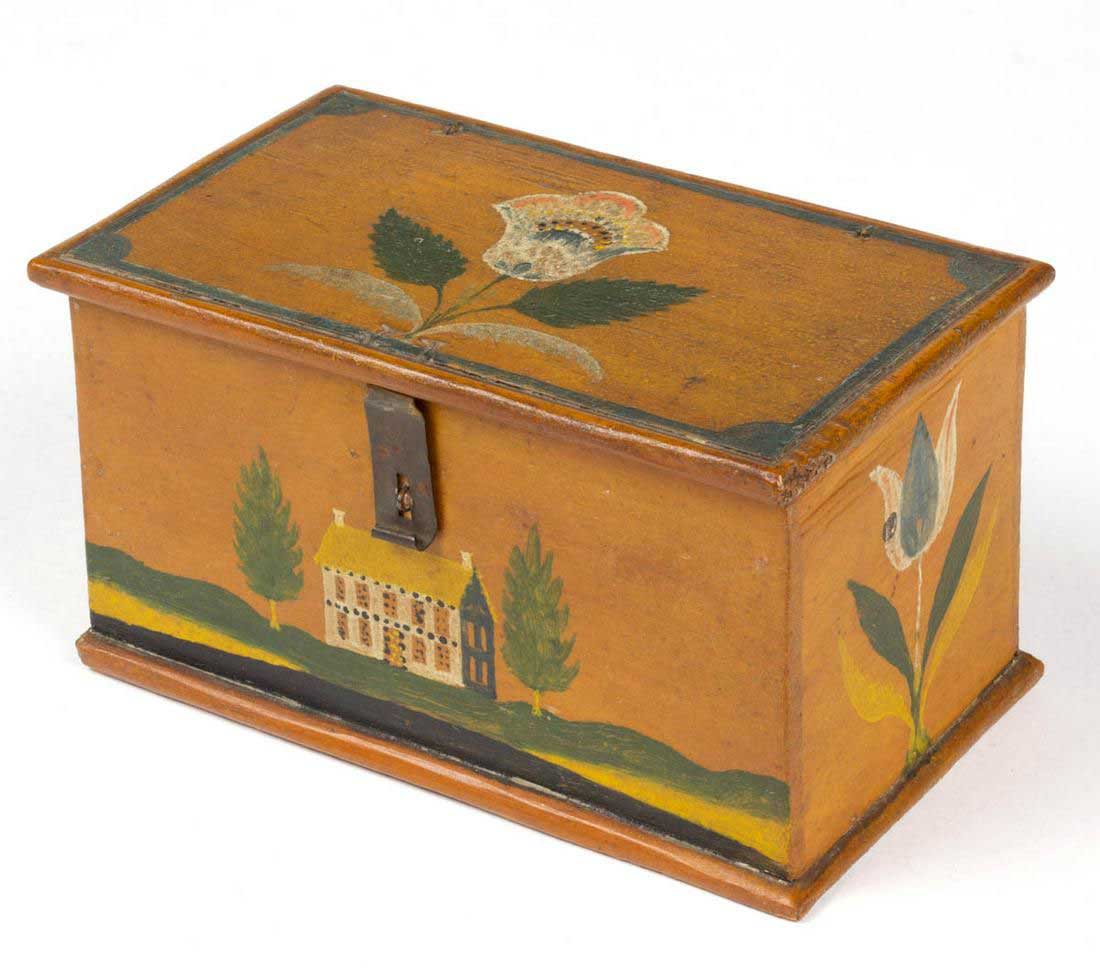January 2022
ANTIQUE DETECTIVE
Small, antique painted wooden boxes can have big price tag
by Anne Gilbert
The humble wooden boxes
The humble wooden boxes made in 18th-century America are popular and collectible when colorfully painted. As a November Americana auction proved, if they have a documented German Pennsylvania heritage, prices can zoom. Such was the case for a Lancaster, PA, trinket dresser box with an estimated value of $20,000. It dated from 1810 to 1850. What made it special was that it had been made by Jonas Weber and handed down in the family. The painted depiction of a two story-farmhouse and landscape, along with a date and inscription, added to the value.
Other boxes from New York State and Virginia had estimates of $200 to $600.
Historically, they served all kinds of purposes. Candle boxes were the most decorative and made of pine or poplar. Trinket boxes were often in maple. Spice boxes were contained in colorfully painted spice cabinets that could hold from four to eight or more boxes made to be stacked and nested into one another. The largest on the bottom held herbs. They were sometimes 20 inches long to hold the herbs that had been dried in bunches. Spice boxes contained ginger, pepper and nutmeg.
Bridal boxes were often 19 inches in length and colorfully painted, depicting a bride and groom and flowers. Some carried romantic inscriptions.

Candlebox
A 19th-century poplar Candlebox. (Image courtesy of Jeffrey S. Evans & Associates Mt. Crawford, VA)
Tulips and morning glories were the flowers of choice along with painted panels. Sometimes the name of the owner and date were inscribed. The painted colors that have survived were red, blue, yellow and green. They were made from the clay in the soil mixed with berries, bark and the indigo plant.
When you see how thin the wood is used in the construction, considering the primitive tools used, it is amazing they survived. First, a strip of wood was thinned and a pointed lap was made. The more decorative the laps, the pricier the piece. Next, it was soaked or steamed to make it pliable. Other times, molds were used to shape the boxes.
CLUES:
Would you recognize a cheese box or a butter box if you saw them? While both are round, cheese boxes were pegged with wooden pegs and made of ash or oak. The cheese was wrapped in gauze.
The butter box was staved and hooped since the butter was moist and the staves had to “give.” White pine that had no scent was used for staves, tops and bottoms.
Early boxes can be recognized by the use of handmade nails that were cut, pounded out and shaped by a blacksmith on an anvil.
Later boxes used machine-made nails.
Surprisingly, old boxes retain their scents. Newly-made reproductions will smell like new wood.
Before spending too much as what is offered as an antique painted box do your research. If possible, visit museum collections. Examine a potential purchase for the above-mentioned clues. An early rarity can turn up anywhere.
Anne Gilbert has been self-syndicating the ANTIQUE DETECTIVE to such papers as the Chicago Sun-Times and the Miami Herald since 1983.
She has authored nine books on antiques, collectibles, and art and appeared on national TV.
She has done appraisals for museums and private individuals.

